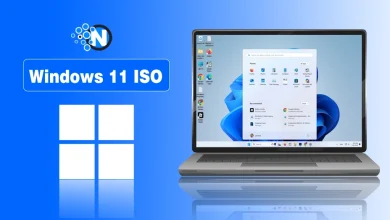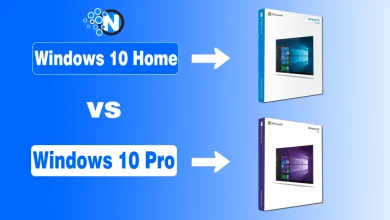Windows 11 vs Windows 10 – Which One is Better?

Windows introduced a new update on October 5 2021, Windows 11. Following the successful tenure of Windows 10, Windows 11 is on track. No doubt, the newer version or an update is always an improved version of the last one.
But before making the switch, many users and professionals are left asking: Is Windows 11 truly better, or does Windows 10 still hold its ground?
In this blog post, you will find a comprehensive comparison of Windows 11 vs Windows 10 to make a well informed decision.
Let’s start!
Windows 11 vs Windows 10 Comparison

Interface & Design
Windows 10
- Retains the familiar layout that most Windows users have grown comfortable with over the years.
- Start Menu and Taskbar are positioned on the left side, fostering ease of access and workflow for traditional users.
- Visuals maintain a functional look, ideal for users who prioritize simple usability over aesthetic flair.
Windows 11
- Features a clean, modern redesign with a centred Start Menu and Taskbar, providing symmetry and streamlined navigation.
- Uses rounded corners, subtle shadows, and fluid animations that offer a polished and premium feel.
- Introduces new multitasking tools like Snap Layouts, Snap Groups, and virtual desktops that drastically improve productivity.
Windows 11 vs Windows 10 Performance & Optimization
Windows 10
- Exceptionally stable, having matured through years of iterative updates and patches.
- Compatible with older hardware, allowing continued use without costly upgrades.
- Excellent performance with low system requirements, making it a preferred choice for budget-conscious users and organizations.
Windows 11
- Optimized for modern processors and advanced hardware architecture, such as multi-core chips and SSDs.
- Includes better power management, faster resume from sleep, and enhanced application responsiveness.
- Background tasks are intelligently managed to minimise resource consumption.
Security & Updates
Windows 10
- Regular security updates continue to roll out through Microsoft’s support lifecycle.
- Includes features like Windows Hello, BitLocker, and Defender Antivirus, but lacks modern implementations like hardware-enforced security.
Windows 11
- Elevates built-in security with secure boot, virtualization-based security (VBS), and mandatory TPM 2.0 support.
- Supports Pluton security processor on some devices, offering integrated chip-level protection.
- Enhanced biometric authentication and ransomware protection mechanisms.
App Compatibility
Windows 10
- Supports a wide range of legacy applications, device drivers, and third-party software, perfect for businesses with long-standing systems.
- Proven interoperability with older peripherals, reducing the hassle of replacing accessories or reconfiguring setups.
Windows 11
- Introduces native support for Android apps via the Amazon Appstore (still expanding).
- Improves support for newer gaming technologies like AutoHDR and DirectStorage, which significantly cut game load times.
- Regular updates to the Microsoft Store with a cleaner interface and better app curation.
Windows 11 vs Windows 10 Gaming Performance 2025
It includes features including Direct storage and Auto HDR for the purpose of improving your gaming experiences. It incorporate features that are exclusively found on Xbox Console. This is one of the positive steps Microsoft has taken toward the integration of Xbox consoles and Computer operating systems.
| Feature | Windows 10 | Windows 11 |
|---|---|---|
| DirectX 12 Ultimate | Yes | Yes |
| AutoHDR | No | Yes |
| DirectStorage | No | Yes |
| Xbox Game Pass Support | (basic) | (native) |
| Optimization for SSDs | Moderate | High |
Should You Consider Upgrading to Windows 11 from Windows 10?
If your hardware meets the requirements and you value a more modern, secure, and productivity-driven environment, Windows 11 offers some meaningful advantages. Here is a quick features comparison for your ease:
Windows 11 vs Windows 10 Differences
| Feature | Windows 10 | Windows 11 |
|---|---|---|
| User Interface | Classic layout, Start Menu on left | Modern design, centered Start Menu and Taskbar |
| Snap Layouts & Multitasking | Basic window snapping | Advanced Snap Layouts, Snap Groups, and Virtual Desktops |
| Performance Optimization | Optimized for older hardware | Enhanced for newer CPUs, better battery and wake performance |
| System Requirements | Broad compatibility, runs on legacy systems | Requires TPM 2.0, Secure Boot, and newer CPUs |
| Security Features | Windows Hello, BitLocker, Defender | Secure Boot, VBS, Pluton (chip-level), stronger integration |
| Gaming Enhancements | DirectX 12, Xbox Game Bar | DirectStorage, AutoHDR, Xbox App integration |
| Android App Support | Not supported | Native support via Amazon Appstore |
| Customization | High—registry tweaks, Start Menu control | Limited—some options are locked or restricted |
| Microsoft Store | Older layout and app curation | Redesigned store, more apps and better developer policies |
| Touch & Pen Support | Supported but basic | More responsive and fluid input tools |
| Teams Integration | Separate install required | Built-in, streamlined for hybrid collaboration |
| Virtual Desktop Experience | Supported | More flexible and customizable |
| Support Lifecycle | Until October 14, 2025 | Actively updated with future support roadmap |
| Target Audience | Legacy users, power users, enterprise teams | Hybrid workers, gamers, content creators |
Requirements to Upgrade from Windows 10 to Windows 11
If you are considering to upgrade from Windows 10 to Windows 11 on your currunt device, you should check the following requirements:
- Processor: 1 GHz or faster with 2 or more cores on a 64-bit processor. Microsoft maintains a list of compatible processors.
- RAM: 4 GB or more.
- Storage: 64 GB or larger storage device.
- System Firmware: UEFI, Secure Boot capable.
- TPM: Trusted Platform Module (TPM) version 2.0.
💡Note: Windows 11 does come with stringent system requirements, such as TPM 2.0 and specific CPU generations, that may limit its availability on older devices
Windows 11 vs Windows 10 – Key Takeaway
Windows 11 is a bold step into the future, featuring superb graphics, enhanced protection, and smarter integrations. It is a Windows upgrade designed to push the limits of productivity and entertainment. However, Windows 10 still holds its laurels with unrivalled compatibility, versatility and reliable user experience.
It does not matter if you are operating a creative studio, enterprise systems, or just dashing through this digital life; your best operating system will vary depending on the objectives you are going to achieve. You can also check reviews on Windows 11 vs Windows 10 to make a wise decision about upgrading to Windows 11.




